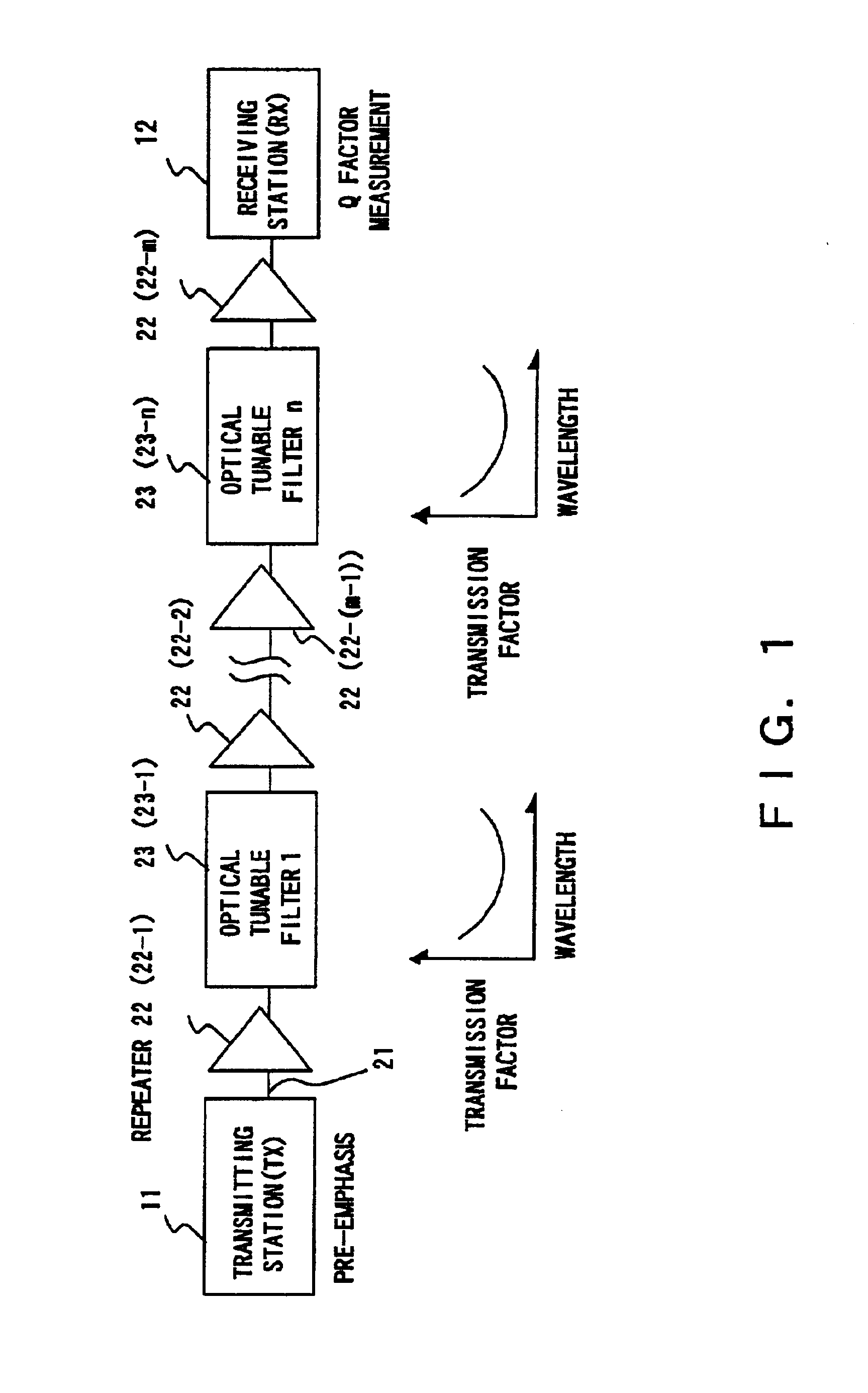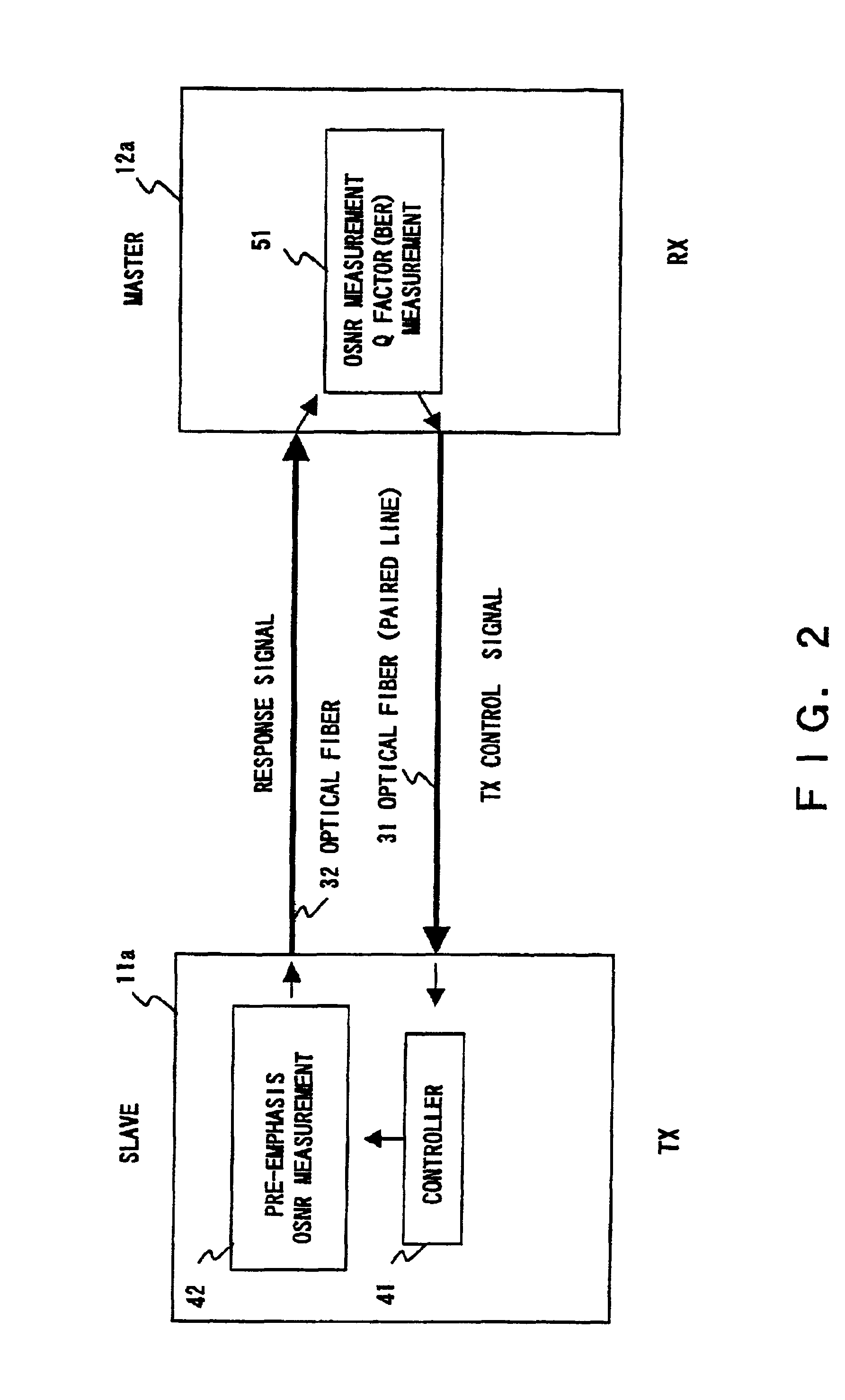System and method for equalizing transmission characteristics in wavelength division multiplexing optical communication system
a transmission characteristic and wavelength division multiplexing technology, applied in multiplex communication, transmission monitoring, instruments, etc., can solve the problems of difficult evaluation of the reliability of optical communication systems based on optical amplification using edfas, affecting succeeding stages, and unable to remove the noise produced at each stage, so as to reduce the burden of pre-emphasis control and improve transmission quality.
- Summary
- Abstract
- Description
- Claims
- Application Information
AI Technical Summary
Benefits of technology
Problems solved by technology
Method used
Image
Examples
first embodiment
[First Embodiment]
FIGS. 2 and 3 are schematic conceptual diagrams for use in explaining the overall operation of a first embodiment of the invention applied to the system of FIG. 1. More specifically, FIG. 2 is a diagram for use in explaining the operation of a receiving station 12a to control the pre-emphasis in a transmitting station 11a and FIG. 3 is a diagram for use in explaining the operation of the receiving station 12a to control the optical tunable filters 23 via the transmitting station 11. In the first embodiment, the receiving station 12a serves as the master station, while the transmitting station 11a serves as the slave station. Note that the optical filters 23 are omitted in FIG. 2. Each of the control operations will be described briefly below.
(A) Control of the pre-emphasis in the transmitting station (FIG. 2)
The receiving station 12a has a measurement section 51 that functions as a transmission characteristic measurement unit and a transmission characteristic contr...
second embodiment
[Second Embodiment]
FIGS. 14 and 15 are schematic diagrams for use in explaining the overall operation of a second embodiment of the present invention which is applied to the system of FIG. 1. More specifically, FIG. 14 is a diagram for use in explaining the operation of a transmitting station 11b to control a receiving station 12b and FIG. 15 is a diagram for use in explaining the operation of the transmitting station 11b to control an optical tunable filter 23. In FIG. 14, the optical tunable filter 23 is omitted. Hereinafter, each control operation will be described briefly.
(A) Pre-emphasis control in the transmitting station (FIG. 14)
The transmitting station 11b has a controller 61 and a pre-emphasis controller 62 serving as a transmission characteristic control unit and sends instructions to the receiving station 12b over an optical fiber 32 to measure OSNRs and Q factors and to send back the measurements.
The receiving station 12a has a measurement section 71 as a transmission c...
third embodiment
The third embodiment and the first embodiment differ from each other only in that the first Q equalization is made only through the filter control or the pre-emphasis control. A detailed description of the third embodiment is omitted herein. Such a third embodiment will also provide the same advantages as the first embodiment.
Of course, the second embodiment may also be modified such that the Q factor equalization is first performed through only the pre-emphasis control and then the Q factor equalization and optimization are performed through both the filter control and the pre-emphasis control with reference to the amounts of pre-emphasis at the time of the first pre-emphasis control.
[Other Embodiments]
(1) In the above embodiments, as the control signal transmission method, the control signal is transmitted in the overhead as shown in FIG. 7A; however, this is not restrictive. In the present invention, basically the control signal may be transmitted in any form. The preferred trans...
PUM
 Login to View More
Login to View More Abstract
Description
Claims
Application Information
 Login to View More
Login to View More - R&D
- Intellectual Property
- Life Sciences
- Materials
- Tech Scout
- Unparalleled Data Quality
- Higher Quality Content
- 60% Fewer Hallucinations
Browse by: Latest US Patents, China's latest patents, Technical Efficacy Thesaurus, Application Domain, Technology Topic, Popular Technical Reports.
© 2025 PatSnap. All rights reserved.Legal|Privacy policy|Modern Slavery Act Transparency Statement|Sitemap|About US| Contact US: help@patsnap.com



